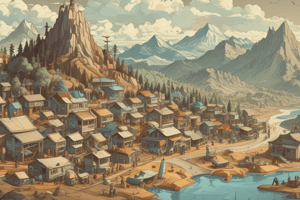Podcast
Questions and Answers
According to Malthusian theory, what happens if the human population increases unchecked?
According to Malthusian theory, what happens if the human population increases unchecked?
- Food supply increases at the same rate.
- The population grows linearly.
- The number of people increases faster than food production. (correct)
- Technological advancements ensure a stable food supply.
Zero population growth indicates a decrease in the population size.
Zero population growth indicates a decrease in the population size.
False (B)
What is the formula for calculating natural population change?
What is the formula for calculating natural population change?
Birth Rate - Death Rate
The number of deaths of children less than one year old per 1000 live births is known as the ______ rate.
The number of deaths of children less than one year old per 1000 live births is known as the ______ rate.
Which of the following factors contributes to a high birth rate in Stage 1 of the Demographic Transition Model?
Which of the following factors contributes to a high birth rate in Stage 1 of the Demographic Transition Model?
In Stage 2 of the Demographic Transition Model, birth rates decrease rapidly due to improved economic conditions.
In Stage 2 of the Demographic Transition Model, birth rates decrease rapidly due to improved economic conditions.
Name one factor that leads to declining birth rates in Stage 3 of the Demographic Transition Model.
Name one factor that leads to declining birth rates in Stage 3 of the Demographic Transition Model.
In Stage 4 of the Demographic Transition Model, birth rates and death rates are ______.
In Stage 4 of the Demographic Transition Model, birth rates and death rates are ______.
What characterizes Stage 5 of the Demographic Transition Model?
What characterizes Stage 5 of the Demographic Transition Model?
The Demographic Transition Model is primarily based on observations of less economically developed countries.
The Demographic Transition Model is primarily based on observations of less economically developed countries.
Define population density.
Define population density.
Areas with population densities of 200-1000+ persons/km square are considered to be ______.
Areas with population densities of 200-1000+ persons/km square are considered to be ______.
Match the following stages from the DTM with their corresponding characteristics:
Match the following stages from the DTM with their corresponding characteristics:
Which environmental factor most directly affects agricultural practices and, consequently, population distribution?
Which environmental factor most directly affects agricultural practices and, consequently, population distribution?
Steep slopes generally promote high population densities due to ease of cultivation.
Steep slopes generally promote high population densities due to ease of cultivation.
How can improved technology affect population distribution?
How can improved technology affect population distribution?
Fertile soils, like those found in river deltas, generally lead to ______ population densities.
Fertile soils, like those found in river deltas, generally lead to ______ population densities.
Which of these is a key example of how resources directly influence population density?
Which of these is a key example of how resources directly influence population density?
According to the context, areas with limited resources always have low population density regardless of technological advancements.
According to the context, areas with limited resources always have low population density regardless of technological advancements.
Match each region with its described population characteristic:
Match each region with its described population characteristic:
Flashcards
Malthusian Theory
Malthusian Theory
World populations increase geometrically while food resources increase arithmetically, leading to potential overpopulation dangers.
Population Growth
Population Growth
The change in population size, whether positive or negative, across the world.
Birth Rate
Birth Rate
Number of live births per 1000 people in a year.
Death Rate
Death Rate
Signup and view all the flashcards
Natural Population Change
Natural Population Change
Signup and view all the flashcards
Infant Mortality Rate
Infant Mortality Rate
Signup and view all the flashcards
Demographic Transition Model (DTM)
Demographic Transition Model (DTM)
Signup and view all the flashcards
Stage 1: High Stationary
Stage 1: High Stationary
Signup and view all the flashcards
Stage 2: Early Expanding
Stage 2: Early Expanding
Signup and view all the flashcards
Stage 3: Late Expanding
Stage 3: Late Expanding
Signup and view all the flashcards
Stage 4: Low Stationary
Stage 4: Low Stationary
Signup and view all the flashcards
Population Density
Population Density
Signup and view all the flashcards
Climate (Population Distribution)
Climate (Population Distribution)
Signup and view all the flashcards
Relief (Population Distribution)
Relief (Population Distribution)
Signup and view all the flashcards
Resources Effect on Pop. Dist.
Resources Effect on Pop. Dist.
Signup and view all the flashcards
Level of Technology
Level of Technology
Signup and view all the flashcards
Resources for Survival
Resources for Survival
Signup and view all the flashcards
Study Notes
- S2 Geography is studying population in Unit 1.
Malthusian Theory
- The global population will increase geometrically.
- Food resources for the population will increase arithmetically.
- Potential dangers of overpopulation are highlighted.
- Uncontrolled human populations increase faster than food supplies.
- Human populations will eventually exceed food sources.
- Natural events like famine or disease could cause population crashes.
Population Explosion
- Represented by a line graph showing rapid global population growth.
- A trend upward suggests a gradual increase.
- The steepest portion indicates the fastest growth rate.
Population Growth
- Population change can be positive or negative.
- Zero population growth exists when there is no population change.
- Population growth is uneven worldwide.
- The Natural Population Change is calculated as Birth Rate (BR) minus Death Rate (DR).
- Overall Population Change is (BR-DR) + the effect of migration.
- Natural Increase/Decrease, or Natural Population Change, are alternative names for this.
Vital Rates
- Birth Rate is the number of live births per 1,000 people annually.
- Death Rate is the number of deaths per 1,000 people annually.
- Natural Increase/Decrease occurs when the birth rate is more or less than the death rate.
- Infant Mortality Rate is the number of deaths of children under one year old per 1,000 live births.
DTM: Demographic Transition Model
- A temporal model which looks at population change over time.
- It examines the impact of birth and death rates on the total population of a country.
Stage 1: High Stationary
- Pre-industrial, with total population low due to high birth and death rates
- High birth rate caused by reliance on agriculture/manual labor, leading to larger families for a larger workforce.
- Stable replacement level maintenance is sought.
- High death rate is due to high infant mortality and low life expectancy.
- Limited medicine and maternal care causes high infant mortality rates.
- Inadequate sanitation and public health causes low life expectancy.
- Total population is relatively constant.
Stage 2: Early Expanding
- Early industrialization leads to a rapid fall in death rate.
- Birth rate remains high.
- Health improvements especially in pediatric care, which is an important factor in childhood life expectancy.
- Death rates decrease with improved healthcare, education and sanitation.
- Total population rises as births exceed deaths.
Stage 3: Late Expanding
- Death rates are low and birth rates decrease.
- Improved economy, the increase in women's status and increased access to contraception all result in lower birth and death rates.
- Slower total population growth continues until birth rates reach or fall below the replacement level (2.1 births per woman).
Stage 4: Low Stationary
- Industrialized, developed society with both birth and death rates low.
- Strong economies, a highly educated population, and ample healthcare systems result in a decreased birth and death rate.
- The total population is high with a gradual or stable growth rate.
Stage 5: Declining?
- Death rate surpasses the birth rate.
- Economic forces reduce family size and encourage contraception use.
- Birth rates fall as a result of high living costs or enticing job prospects, resulting in birth rates being below the replacement level of 2.1 children per woman.
- An aging population leads to eventual population declines.
Application of the DTM
- Most less economically developed countries are in stage 2 or 3, with a growing population and high natural increase.
- Most more economically developed countries are in stage 4, and some are already in stage 5.
What is DTM based on?
- The model is based on observations of developed countries in the 18th and 19th centuries.
Usefulness of DTMs
- Useful as a framework to measure, evaluate, and understand reality
- A model is a depiction of a real-world phenomena to facilitate understanding it.
- A simplified, generalized version of real-world events, removing incidental details.
Distributions
- Describes distribution of areas that are sparsely/densely populated.
- Sparsely/densely concentrated mostly in the overall pattern with concentrations in specific patterns.
Population Distribution
- Spatial distribution is global population distribution.
- Population density is the number of people per unit of land.
- The formula for population density is (# of People) / Area.
- High density = 200-1000+ persons/km squared.
- Moderate density = 10-199 persons/km squared.
- Low density = 0-9 persons/km squared.
- Look for patterns on a global scale like near the equator or the tropics.
- Cardinal directions and world regions create specific patterns, e.g. northern South America.
Factors Affecting Population Distribution
- These include physical environment factors.
Climate Factors
- Rainfall and temperature over time that affect living conditions and agriculture.
- Extreme temperatures repel settlement.
- Agriculture provides food, which is a basic necessity for a living condition.
- No agriculture causes no basic necessity, in turn not a suitable environment.
Relief Factors
- Relief refers to height and gradient which affect drainage and agriculture.
- Steep slopes, unless terraced, are unsuitable for crop growing and lower population density.
- Mountainous, less-accessible regions have low population density.
- Population densities may be higher if relief is higher for safety.
- Flat land is easy to build on and retains water to grow crops.
Soil Factors
- Poor soils affect cultivation, lowering population density specifically in agricultural societies.
- Ganges-Brahmaputra delta and Mekong River delta soils are fertile, leading to high population density.
Resource Factors
- Include water, materials for shelter, food, and minerals which are basic needs.
- Population density lowers without these unless mitigated by technology.
Technology Factors
- Refers to the skills, knowledge and tools to meet needs.
- With technological advances, environments that were previously unsuitable are converted.
- Water can be piped into the desert for living.
Studying That Suits You
Use AI to generate personalized quizzes and flashcards to suit your learning preferences.




